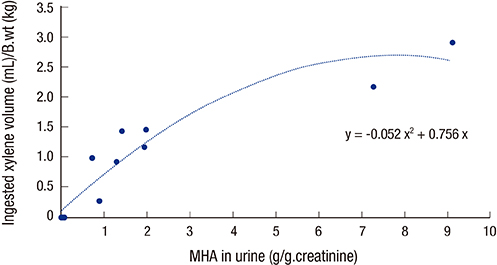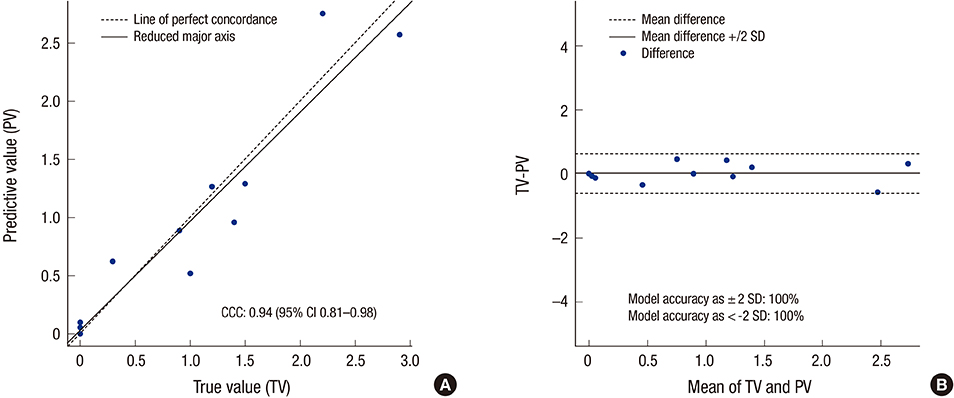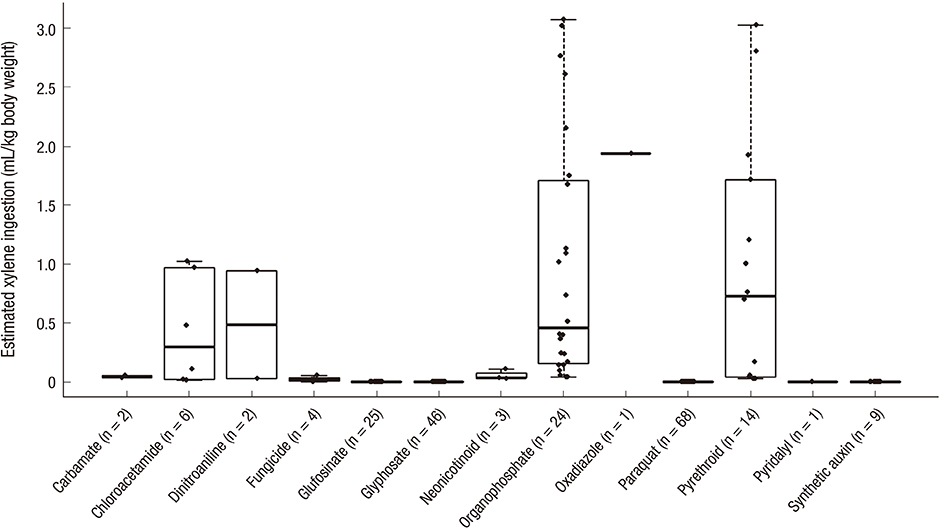J Korean Med Sci.
2017 Dec;32(12):2051-2057. 10.3346/jkms.2017.32.12.2051.
Urine Methyl Hippuric Acid Levels in Acute Pesticide Poisoning: Estimation of Ingested Xylene Volume and Association with Clinical Outcome Parameters
- Affiliations
-
- 1Department of Internal Medicine, Soonchunhyang University Cheonan Hospital, Cheonan, Korea. syhong@sch.ac.kr
- 2Department of Biostatistics, Soonchunhyang University, College of Medicine, Seoul, Korea.
- KMID: 2396385
- DOI: http://doi.org/10.3346/jkms.2017.32.12.2051
Abstract
- To determine the relationship between the oral ingestion volume of xylene and methyl hippuric acid (MHA) in urine, we measured MHA in 11 patients whose ingested xylene volume was identified. The best-fit equation between urine MHA and ingested amount of xylene was as follows: y (ingested amount of xylene, mL/kg) = −0.052x² + 0.756x (x = MHA in urine in g/g creatinine). From this equation, we estimated the ingested xylene volume in 194 patients who had ingested pesticide of which the formulation was not available. Our results demonstrated that oxadiazole, dinitroaniline, chloroacetamide, organophosphate, and pyrethroid were xylene-containing pesticide classes, while the paraquat, glyphosate, glufosinate, synthetic auxin, fungicide, neonicotinoid, and carbamate classes were xylene-free pesticides. Sub-group univariate analysis showed a significant association between MHA levels in urine and ventilator necessity in the pyrethroid group. However, this association was not observed in the organophosphate group. Our results suggest that MHA in urine is a surrogate marker for xylene ingestion, and high urine MHA levels may be a risk factor for poor clinical outcome with some pesticide poisoning.
MeSH Terms
Figure
Reference
-
1. Lee JW, Hwang IW, Kim JW, Moon HJ, Kim KH, Park S, Gil HW, Hong SY. Common pesticides used in suicide attempts following the 2012 paraquat ban in Korea. J Korean Med Sci. 2015; 30:1517–1521.2. Gil HW, Hong JR, Jang SH, Hong SY. Diagnostic and therapeutic approach for acute paraquat intoxication. J Korean Med Sci. 2014; 29:1441–1449.3. Sohn K. The trend in suicide methods in South Korea in 1997–2015. Death Stud. 2017; 41:303–310.4. Wang T, Bo P, Bing T, Zhaoyun Z, Liyu D, Yonglong L. Benzene homologues in environmental matrixes from a pesticide chemical region in China: occurrence, health risk and management. Ecotoxicol Environ Saf. 2014; 104:357–364.5. Inoue O, Seiji K, Kawai T, Watanabe T, Jin C, Cai SX, Chen Z, Qu QS, Zhang T, Ikeda M. Excretion of methylhippuric acids in urine of workers exposed to a xylene mixture: comparison among three xylene isomers and toluene. Int Arch Occup Environ Health. 1993; 64:533–539.6. Bland JM, Altman DG. Statistical methods for assessing agreement between two methods of clinical measurement. Lancet. 1986; 1:307–310.7. Lin LI. A concordance correlation coefficient to evaluate reproducibility. Biometrics. 1989; 45:255–268.8. Carayon P, Alvarado CJ. Systems Engineering Initiative for Patient Safety. Workload and patient safety among critical care nurses. Crit Care Nurs Clin North Am. 2007; 19:121–129.9. Salluh JI, Soares M. ICU severity of illness scores: APACHE, SAPS and MPM. Curr Opin Crit Care. 2014; 20:557–565.10. Soderlund DM, Clark JM, Sheets LP, Mullin LS, Piccirillo VJ, Sargent D, Stevens JT, Weiner ML. Mechanisms of pyrethroid neurotoxicity: implications for cumulative risk assessment. Toxicology. 2002; 171:3–59.11. Gotoh Y, Kawakami M, Matsumoto N, Okada Y. Permethrin emulsion ingestion: clinical manifestations and clearance of isomers. J Toxicol Clin Toxicol. 1998; 36:57–61.12. Yang PY, Lin JL, Hall AH, Tsao TC, Chern MS. Acute ingestion poisoning with insecticide formulations containing the pyrethroid permethrin, xylene, and surfactant: a review of 48 cases. J Toxicol Clin Toxicol. 2002; 40:107–113.13. Hulse EJ, Davies JO, Simpson AJ, Sciuto AM, Eddleston M. Respiratory complications of organophosphorus nerve agent and insecticide poisoning. Implications for respiratory and critical care. Am J Respir Crit Care Med. 2014; 190:1342–1354.14. Indira M, Andrews MA, Rakesh TP. Incidence, predictors, and outcome of intermediate syndrome in cholinergic insecticide poisoning: a prospective observational cohort study. Clin Toxicol (Phila). 2013; 51:838–845.15. Gralewicz S, Wiaderna D, Tomas T. Development of spontaneous, age-related nonconvulsive seizure electrocortical activity and radial-maze learning after exposure to m-xylene in rats. Int J Occup Med Environ Health. 1995; 8:347–360.
- Full Text Links
- Actions
-
Cited
- CITED
-
- Close
- Share
- Similar articles
-
- Hippuric Acid Levels in Paint Workers at Steel Furniture Manufacturers in Thailand
- A Study on the Effects of Taking the Drink Containing Benzoic Acid on Analysis of Hippuric Acid in Urine
- Effect of Sodium Benzoate on Change of Urinary Hippuric Acid and Methyl Hippuric Acid among Workers Coexposed to Toluene and Xylene
- Incidence, Etiology, and Outcomes of Rhabdomyolysis in a Single Tertiary Referral Center
- Risk Factors to Predict Acute Respiratory Failure in Patients with Acute Pesticide Poisoning




